The Great Sphinx of Giza is a limestone statue of a reclining sphinx, a mythical creature with the head of a human and the body of a lion. Facing directly from west to east, it stands on the Giza Plateau on the west bank of the Nile in Giza, Egypt. The face of the Sphinx appears to represent the pharaoh Khafre. The original shape of the Sphinx was cut from the bedrock, and has since been restored with layers of limestone blocks. It measures 73 m (240 ft) long from paw to tail, 20 m (66 ft) high from the base to the top of the head and 19 m (62 ft) wide at its rear haunches.
The Sphinx is the oldest known monumental sculpture in Egypt and one of the most recognizable statues in the world. The archaeological evidence suggests that it was created by ancient Egyptians of the Old Kingdom during the reign of Khafre (c. 2558–2532 BC).
The circumstances surrounding the Sphinx's nose being broken off are...Read more
The Great Sphinx of Giza is a limestone statue of a reclining sphinx, a mythical creature with the head of a human and the body of a lion. Facing directly from west to east, it stands on the Giza Plateau on the west bank of the Nile in Giza, Egypt. The face of the Sphinx appears to represent the pharaoh Khafre. The original shape of the Sphinx was cut from the bedrock, and has since been restored with layers of limestone blocks. It measures 73 m (240 ft) long from paw to tail, 20 m (66 ft) high from the base to the top of the head and 19 m (62 ft) wide at its rear haunches.
The Sphinx is the oldest known monumental sculpture in Egypt and one of the most recognizable statues in the world. The archaeological evidence suggests that it was created by ancient Egyptians of the Old Kingdom during the reign of Khafre (c. 2558–2532 BC).
The circumstances surrounding the Sphinx's nose being broken off are uncertain, but close inspection suggests a deliberate act using rods or chisels. Contrary to a popular myth, it was not broken off by cannonfire from Napoleon's troops during his 1798 Egyptian campaign. Its absence is in fact depicted in artwork predating Napoleon and referred to in descriptions by the 15th-century historian al-Maqrīzī.
 Natural rock formation at Farafra, Egypt
Natural rock formation at Farafra, EgyptThe archaeological evidence suggests that the Great Sphinx was created around 2500 BC for the pharaoh Khafre, the builder of the Second Pyramid at Giza.[1] The Sphinx is a monolith carved from the bedrock of the plateau, which also served as the quarry for the pyramids and other monuments in the area.[2] Egyptian geologist Farouk El-Baz has suggested that the head of the Sphinx may have been carved first, out of a natural yardang, i.e. a ridge of bedrock that had been sculpted by the wind. These can sometimes achieve shapes that resemble animals. El-Baz suggests that the "moat" or "ditch" around the Sphinx may have been quarried out later to allow for the creation of the full body of the sculpture.[3] The stones cut from around the Sphinx's body were used to construct a temple in front of it, however neither the enclosure nor the temple were ever completed, and the relative scarcity of Old Kingdom cultural material suggests that a Sphinx cult was not established at the time.[4] Selim Hassan, writing in 1949 on recent excavations of the Sphinx enclosure, made note of this circumstance:
Taking all things into consideration, it seems that we must give the credit of erecting this, the world's most wonderful statue, to Khafre, but always with this reservation: that there is not one single contemporary inscription which connects the Sphinx with Khafre, so sound as it may appear, we must treat the evidence as circumstantial, until such time as a lucky turn of the spade of the excavator will reveal to the world a definite reference to the erection of the Sphinx.[5]
In order to construct the temple, the northern perimeter-wall of the Khafre Valley Temple had to be deconstructed, hence it follows that the Khafre funerary complex preceded the creation of the Sphinx and its temple. Furthermore, the angle and location of the south wall of the enclosure suggests the causeway connecting Khafre's Pyramid and Valley Temple already existed before the Sphinx was planned. The lower base level of the Sphinx temple also indicates that it does not pre-date the Valley Temple.[6]
New Kingdom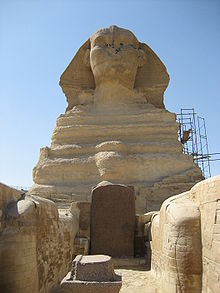 The New Kingdom Dream Stele between the paws of the Sphinx.
The New Kingdom Dream Stele between the paws of the Sphinx.Some time around the First Intermediate Period, the Giza Necropolis was abandoned, and drifting sand eventually buried the Sphinx up to its shoulders. The first documented attempt at an excavation dates to c. 1400 BC, when the young Thutmose IV (1401–1391 or 1397–1388 BC) gathered a team and, after much effort, managed to dig out the front paws, between which he erected a shrine that housed the Dream Stele, an inscribed granite slab (possibly a repurposed door lintel from one of Khafre's temples). When the stele was discovered, its lines of text were already damaged and incomplete. An excerpt reads:
... the royal son, Thothmos, being arrived, while walking at midday and seating himself under the shadow of this mighty god, was overcome by slumber and slept at the very moment when Ra is at the summit [of heaven]. He found that the Majesty of this august god spoke to him with his own mouth, as a father speaks to his son, saying: Look upon me, contemplate me, O my son Thothmos; I am thy father, Harmakhis-Khopri-Ra-Tum; I bestow upon thee the sovereignty over my domain, the supremacy over the living ... Behold my actual condition that thou mayest protect all my perfect limbs. The sand of the desert whereon I am laid has covered me. Save me, causing all that is in my heart to be executed.[7]
The Dream Stele associates the Sphinx with Khafre, however this part of the text is not entirely intact:
which we bring for him: oxen ... and all the young vegetables; and we shall give praise to Wenofer ... Khaf ... the statue made for Atum-Hor-em-Akhet.[8]
Egyptologist Thomas Young, finding the Khaf hieroglyphs in a damaged cartouche used to surround a royal name, inserted the glyph ra to complete Khafre's name. When the Stele was re-excavated in 1925, the lines of text referring to Khaf flaked off and were destroyed.[citation needed]
Later, Ramesses II the Great (1279–1213 BC) may have undertaken a second excavation.
In the New Kingdom, the Sphinx became more specifically associated with the sun god Hor-em-akhet (Hellenized: Harmachis) or "Horus-at-the-Horizon". The Pharaoh Amenhotep II (1427–1401 or 1397 BC) built a temple to the northeast of the Sphinx nearly 1,000 years after its construction and dedicated it to the cult of Hor-em-akhet.[9]
Graeco-Roman periodIn Graeco-Roman times, Giza had become a tourist destination—the monuments were regarded as antiquities—and some Roman Emperors visited the Sphinx out of curiosity, and for political reasons.[10]
The Sphinx was cleared of sand again in the first century AD in honor of Emperor Nero and the Governor of Egypt Tiberius Claudius Balbilus.[11] A monumental stairway—more than 12 metres (39 ft) wide—was erected, leading to a pavement in front of the paws of the Sphinx. At the top of the stairs, a podium was positioned that allowed a view into the Sphinx sanctuary. Farther back, another podium neighbored several more steps.[12] The stairway was dismantled during the 1931–32 excavations by Émile Baraize.[13]
Pliny the Elder describes the face of the Sphinx being colored red and gives measurements for the statue:[14]
A stela dated to 166 AD commemorates the restoration of the retaining walls surrounding the Sphinx.[15] The last Emperor connected with the monument is Septimius Severus, around 200 AD.[16] With the downfall of Roman power, the Sphinx was once more engulfed by the sands.[17]



Some ancient non-Egyptians saw the Sphinx as a likeness of the god Hauron. The cult of the Sphinx continued into medieval times. The Sabians of Harran saw it as the burial place of Hermes Trismegistus. Arab authors described the Sphinx as a talisman that guarded the area from the desert.[18] Al-Maqrizi describes it as the "talisman of the Nile" that the locals believed the flood cycle depended upon.[19] Muhammad al-Idrisi stated that those wishing to obtain bureaucratic positions in the Egyptian government gave incense offering to the monument.[20]
Early modern periodOver the centuries, writers and scholars have recorded their impressions and reactions upon seeing the Sphinx. The vast majority were concerned with a general description, often including a mixture of science, romance and mystique.[citation needed] A typical[citation needed] description of the Sphinx by tourists and leisure travelers throughout the 19th and 20th century was made by John Lawson Stoddard:
It is the antiquity of the Sphinx which thrills us as we look upon it, for in itself it has no charms. The desert's waves have risen to its breast, as if to wrap the monster in a winding-sheet of gold. The face and head have been mutilated by Moslem fanatics. The mouth, the beauty of whose lips was once admired, is now expressionless. Yet grand in its loneliness, – veiled in the mystery of unnamed ages, – the relic of Egyptian antiquity stands solemn and silent in the presence of the awful desert – symbol of eternity. Here it disputes with Time the empire of the past; forever gazing on and on into a future which will still be distant when we, like all who have preceded us and looked upon its face, have lived our little lives and disappeared.[21]
From the 16th to the 19th centuries, European observers described the Sphinx having the face, neck and breast of a woman. Examples included Johannes Helferich (1579), George Sandys (1615), Johann Michael Vansleb (1677), Benoît de Maillet (1735) and Elliot Warburton (1844).
Most early Western images were book illustrations in print form, elaborated by a professional engraver from either previous images available or some original drawing or sketch supplied by an author, and usually now lost. Seven years after visiting Giza, André Thévet (Cosmographie de Levant, 1556) described the Sphinx as "the head of a colossus, caused to be made by Isis, daughter of Inachus, then so beloved of Jupiter". He, or his artist and engraver, pictured it as a curly-haired monster with a grassy dog collar. Athanasius Kircher (who never visited Egypt) depicted the Sphinx as a Roman statue (Turris Babel, 1679). Johannes Helferich's (1579) Sphinx is a pinched-face, round-breasted woman with a straight haired wig. George Sandys stated that the Sphinx was a harlot; Balthasar de Monconys interpreted the headdress as a kind of hairnet, while François de La Boullaye-Le Gouz's Sphinx had a rounded hairdo with bulky collar.[citation needed]
Richard Pococke's Sphinx was an adoption of Cornelis de Bruijn's drawing of 1698, featuring only minor changes, but is closer to the actual appearance of the Sphinx than anything previous. The print versions of Norden's drawings for his Voyage d'Egypte et de Nubie, 1755 clearly show that the nose was missing.
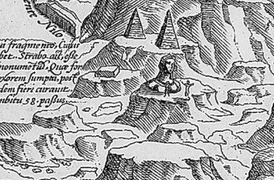
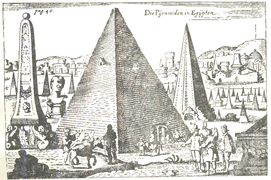
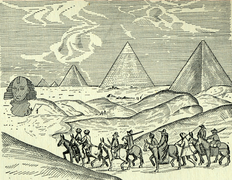
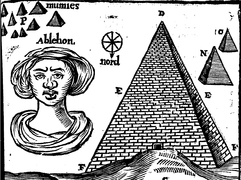
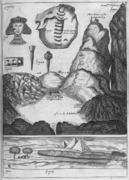

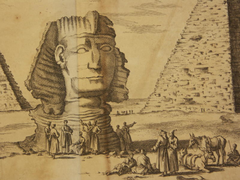


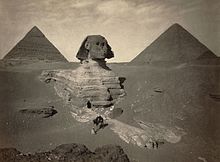 The Great Sphinx partially excavated, ca. 1878
The Great Sphinx partially excavated, ca. 1878 The Sphinx circa 1880s, by Beniamino Facchinelli
The Sphinx circa 1880s, by Beniamino FacchinelliIn 1817, the first modern archaeological dig, supervised by the Italian Giovanni Battista Caviglia, uncovered the Sphinx's chest completely.
In the beginning of the year 1887, the chest, the paws, the altar, and plateau were all made visible. Flights of steps were unearthed, and finally accurate measurements were taken of the great figures. The height from the lowest of the steps was found to be one hundred feet, and the space between the paws was found to be thirty-five feet long and ten feet wide. Here there was formerly an altar; and a stele of Thûtmosis IV was discovered, recording a dream in which he was ordered to clear away the sand that even then was gathering round the site of the Sphinx.[22]
One of the people working on clearing the sands from around the Great Sphinx was Eugène Grébaut, a French Director of the Antiquities Service.[23]
Opinions of early EgyptologistsEarly Egyptologists and excavators were of divided opinion regarding the age of the Sphinx and the associated temples.
In 1857, Auguste Mariette, founder of the Egyptian Museum in Cairo, unearthed the much later Inventory Stela (estimated to be from the Twenty-sixth Dynasty, c. 664–525 BC), which tells how Khufu came upon the Sphinx, already buried in sand. Although certain tracts on the Stela are likely accurate,[24] this passage is contradicted by archaeological evidence, thus considered to be Late Period historical revisionism,[25] a purposeful fake, created by the local priests as an attempt to imbue the contemporary Isis temple with an ancient history it never had. Such acts became common when religious institutions such as temples, shrines and priests' domains were fighting for political attention and for financial and economic donations.[26][27]
Flinders Petrie wrote in 1883 regarding the state of opinion of the age of the Khafre Valley Temple, and by extension the Sphinx: "The date of the Granite Temple has been so positively asserted to be earlier than the fourth dynasty, that it may seem rash to dispute the point. Recent discoveries, however, strongly show that it was really not built before the reign of Khafre, in the fourth dynasty."[28]
Gaston Maspero, the French Egyptologist and second director of the Egyptian Museum in Cairo, conducted a survey of the Sphinx in 1886. He concluded that because the Dream Stela showed the cartouche of Khafre in line 13, it was he who was responsible for the excavation and therefore the Sphinx must predate Khafre and his predecessors—possibly Fourth Dynasty, c. 2575–2467 BC. Maspero believed the Sphinx to be "the most ancient monument in Egypt".[29]
Ludwig Borchardt attributed the Sphinx to the Middle Kingdom, arguing that the particular features seen on the Sphinx are unique to the 12th dynasty and that the Sphinx resembles Amenemhat III.[30]
E. A. Wallis Budge agreed that the Sphinx predated Khafre's reign, writing in The Gods of the Egyptians (1904): "This marvelous object [the Great Sphinx] was in existence in the days of Khafre, or Khephren,[a] and it is probable that it is a very great deal older than his reign and that it dates from the end of the archaic period [c. 2686 BC]."[31]
Selim Hassan reasoned that the Sphinx was erected after the completion of the Khafre pyramid complex.[32]
Modern dissenting hypothesesRainer Stadelmann, former director of the German Archaeological Institute in Cairo, examined the distinct iconography of the nemes (headdress) and the now-detached beard of the Sphinx and concluded the style is more indicative of the pharaoh Khufu (2589–2566 BC), known to the Greeks as Cheops, builder of the Great Pyramid of Giza and Khafre's father.[33] He supports this by suggesting Khafre's Causeway was built to conform to a pre-existing structure, which, he concludes, given its location, could only have been the Sphinx.[34]
In 2004, Vassil Dobrev of the Institut Français d'Archéologie Orientale in Cairo announced he had uncovered new evidence that the Great Sphinx may have been the work of the little-known pharaoh Djedefre (2528–2520 BC), Khafre's half brother and a son of Khufu.[35] Dobrev suggests Djedefre built the Sphinx in the image of his father Khufu, identifying him with the sun god Ra in order to restore respect for their dynasty. Dobrev also says that the causeway connecting Khafre's pyramid to the temples was built around the Sphinx, suggesting it was already in existence at the time. Egyptologist Nigel Strudwick responded to Dobrev saying that: "It is not implausible. But I would need more explanation, such as why he thinks the pyramid at Abu Roash is a sun temple, something I'm sceptical about. I have never heard anyone suggest that the name in the graffiti at Zawiyet el-Aryan mentions Djedefre. I remain more convinced by the traditional argument of it being Khafre or the more recent theory of it being Khufu."[36]
Geologist Colin Reader suggests that water runoff from the Giza plateau is responsible for the differential erosion on the walls of the sphinx enclosure. Because the hydrological characteristics of the area were significantly changed by the quarries, he contends this suggests that the sphinx likely predated the quarries (and thus, the pyramids). He points towards the larger cyclopean stones in part of the Sphinx Temple, as well as the causeway alignment with the pyramids and the break in the quarries, as evidence that the pyramids took the alignment with some pre-existing structure, such as the sphinx, into consideration when they were constructed, and that the sphinx temple was built in two distinct phases. He contends that such erosion could have occurred relatively rapidly and suggests that the sphinx was no more than a few centuries older than present archaeology would suggest, suggesting a late Predynastic or Early Dynastic origin, when Ancient Egyptians already were known to be capable of sophisticated masonry.[25]
Recent restorationsIn 1931, engineers of the Egyptian government repaired the head of the Sphinx. Part of its headdress had fallen off in 1926 due to erosion, which had also cut deeply into its neck.[37] This questionable repair was by the addition of a concrete collar between the headdress and the neck, creating an altered profile.[38] Many renovations to the stone base and raw rock body were done in the 1980s, and then redone in the 1990s.[39]
Cite error: There are <ref group=lower-alpha> tags or {{efn}} templates on this page, but the references will not show without a {{reflist|group=lower-alpha}} template or {{notelist}} template (see the help page).



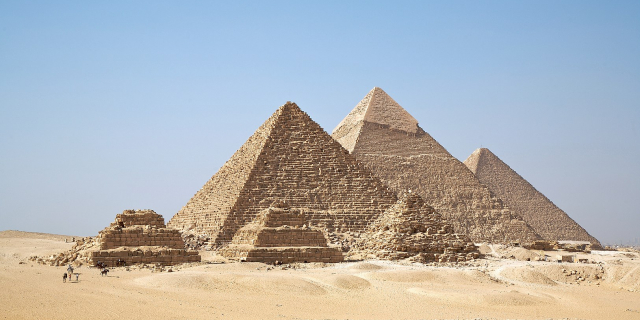
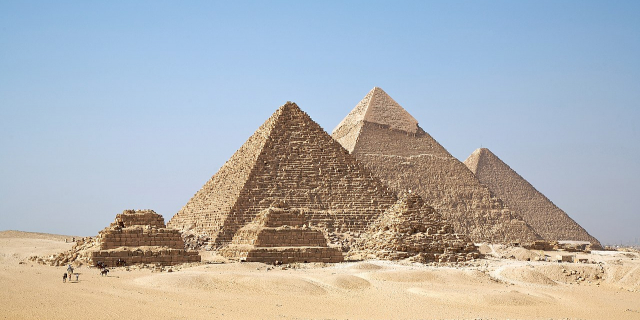



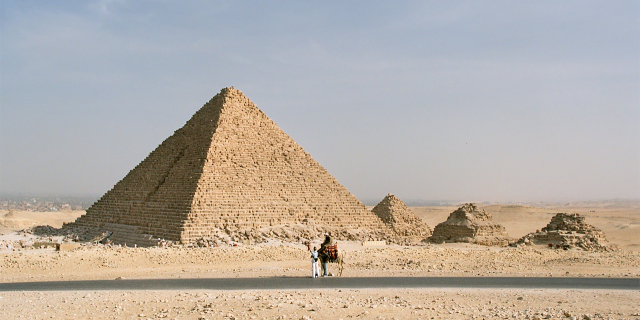

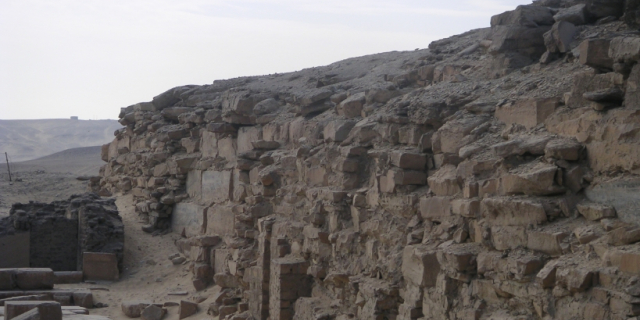
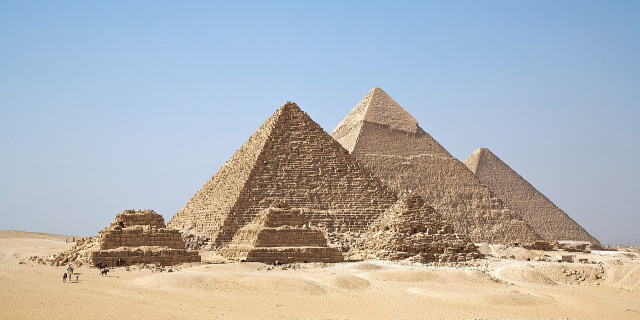
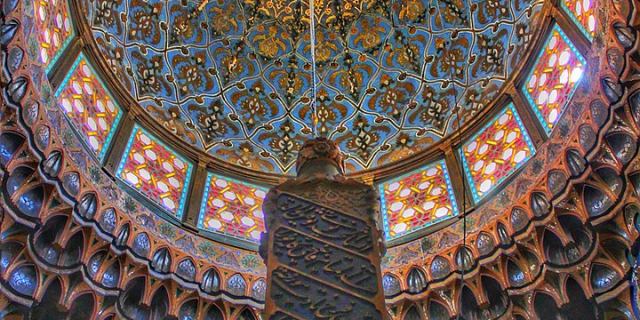




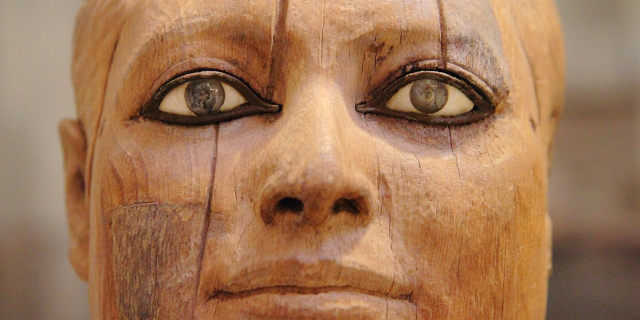




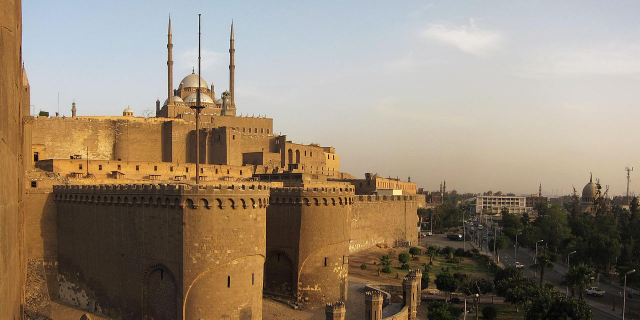

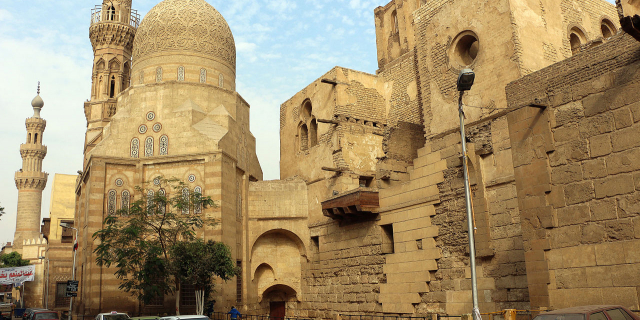

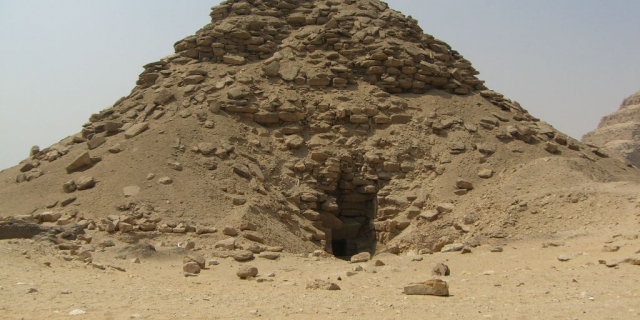

Add new comment